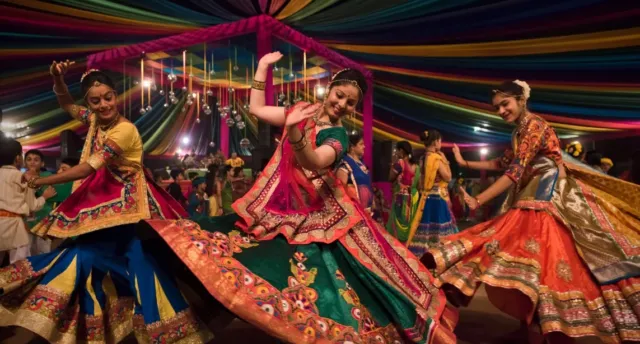
Garba: The Heartbeat of Navratri
Navratri, the nine-night festival dedicated to the worship of the divine feminine, is synonymous with Garba, a vibrant and energetic dance form that originates from the state of Gujarat in India. More than just a dance, Garba is a celebration of life, fertility, and devotion to the goddess Durga.
The word ‘Garba’ is derived from the Sanskrit word ‘Garbha,’ meaning womb, symbolizing the source of life and creation. Traditionally, the dance is performed around a centrally lit lamp or an image of the goddess, representing the divine energy that sustains the universe. The circular movements of the dancers signify the cyclical nature of time and life.
Garba is traditionally performed in a circle, with participants moving in a clockwise direction. This circular movement is symbolic, representing the Hindu concept of time as cyclical. The dancers clap in unison, creating a rhythmic pulse that is both infectious and mesmerizing. The music accompanying Garba is typically devotional, featuring traditional Gujarati folk songs and instruments like the dhol, tabla, and harmonium.
Over the years, Garba has evolved, incorporating modern elements while retaining its core traditions. Today, one can find fusion Garba styles that blend traditional steps with contemporary music and dance forms. The costumes worn during Garba are equally vibrant and colorful, with women typically donning intricately embroidered chaniya cholis (traditional Gujarati attire) and men wearing kedias (short, pleated kurtas) and turbans. The use of mirrors, sequins, and vibrant colors adds to the festive atmosphere.
The significance of Garba extends beyond its religious and cultural aspects. It is also a social event that brings communities together. People of all ages and backgrounds participate in Garba, fostering a sense of unity and togetherness. It is a time for celebration, joy, and the reaffirmation of cultural identity.
During Navratri, Garba events are organized in almost every city and town across India, particularly in Gujarat, Maharashtra, and Rajasthan. These events, often lasting late into the night, are a testament to the enduring popularity of Garba. The dance is not just a performance; it is an experience, a spiritual journey, and a celebration of the divine feminine.
In conclusion, Garba is an integral part of Navratri, embodying the spirit of the festival and the rich cultural heritage of India. It is a dance that celebrates life, fertility, and the divine feminine, bringing communities together in a vibrant and joyous celebration. As the dancers move in unison, clapping and singing, they are not just performing a dance; they are participating in a centuries-old tradition that continues to resonate with people of all ages and backgrounds.
Disclaimer: This news article is based on publicly available information and may be subject to updates.




